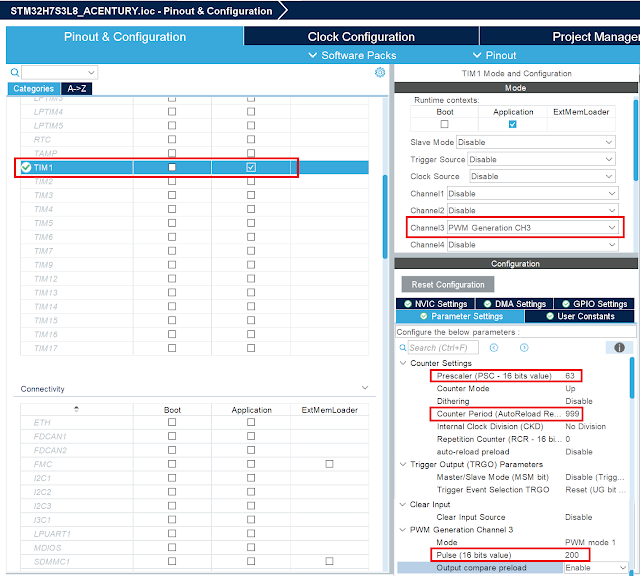To configure Timer1 for a 1 kHz PWM signal with a 20% duty cycle on an STM32H7S3L8 microcontroller, follow these steps:
1. Understand the Timer Parameters
- PWM Frequency: 1 kHz → Period = 1 ms.
- Duty Cycle: 20% → ON time = 0.2 ms.
The timer’s clock frequency is derived from the APB clock (e.g., TIMCLK). Let’s assume you know the APB clock frequency. The Timer prescaler and auto-reload register (ARR) define the PWM frequency.
2. Compute Timer Parameters
Formula:
For 1 kHz PWM:
- Prescaler: Adjust it to reduce the timer clock to a manageable range.
- ARR: Defines the PWM period.
- CCR1 (Compare Register): Controls the duty cycle.
Example: If TIMCLK = 200 MHz:
- Choose Prescaler = 199 (to divide TIMCLK to 1 MHz).
- ARR = 999 (to set a 1 kHz PWM frequency).
- CCR1 = .
3. Code Example
Using HAL in STM32CubeIDE:
IOC
#include "main.h"
void PWM_Config(void)
{
TIM_HandleTypeDef htim1;
TIM_OC_InitTypeDef sConfigOC = {0};
// Initialize Timer1
__HAL_RCC_TIM1_CLK_ENABLE(); // Enable TIM1 clock
htim1.Instance = TIM1;
htim1.Init.Prescaler = 199; // Prescaler to divide clock to 1 MHz
htim1.Init.CounterMode = TIM_COUNTERMODE_UP;
htim1.Init.Period = 999; // ARR value for 1 kHz PWM
htim1.Init.ClockDivision = TIM_CLOCKDIVISION_DIV1;
htim1.Init.RepetitionCounter = 0;
HAL_TIM_PWM_Init(&htim1);
// Configure PWM mode for Channel 1
sConfigOC.OCMode = TIM_OCMODE_PWM1;
sConfigOC.Pulse = 199; // Duty cycle = 20%
sConfigOC.OCPolarity = TIM_OCPOLARITY_HIGH;
sConfigOC.OCFastMode = TIM_OCFAST_DISABLE;
HAL_TIM_PWM_ConfigChannel(&htim1, &sConfigOC, TIM_CHANNEL_1);
// Start PWM on Channel 1
HAL_TIM_PWM_Start(&htim1, TIM_CHANNEL_1);
}

Comments
Post a Comment